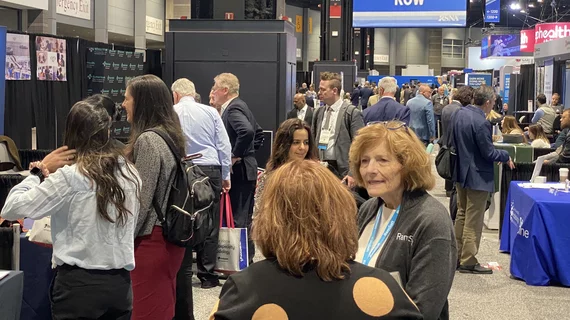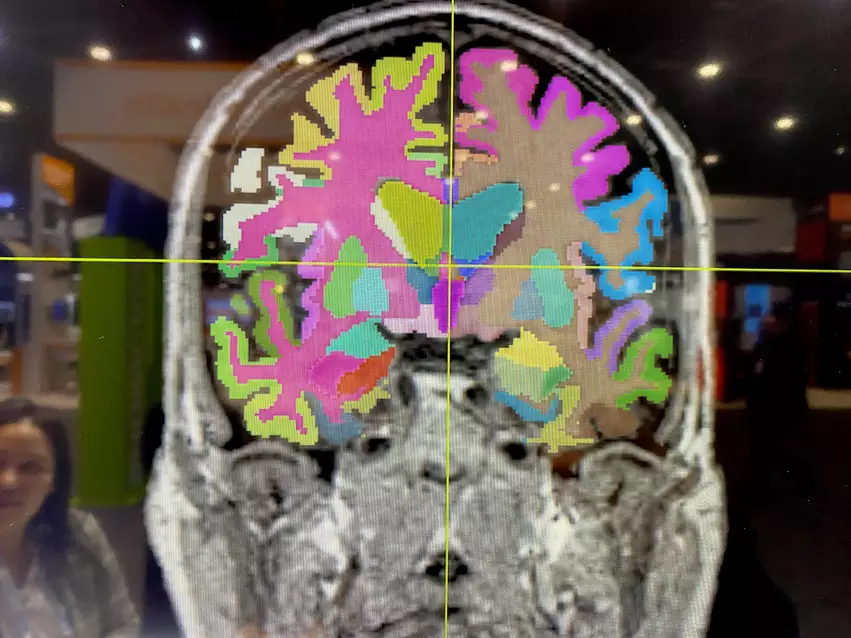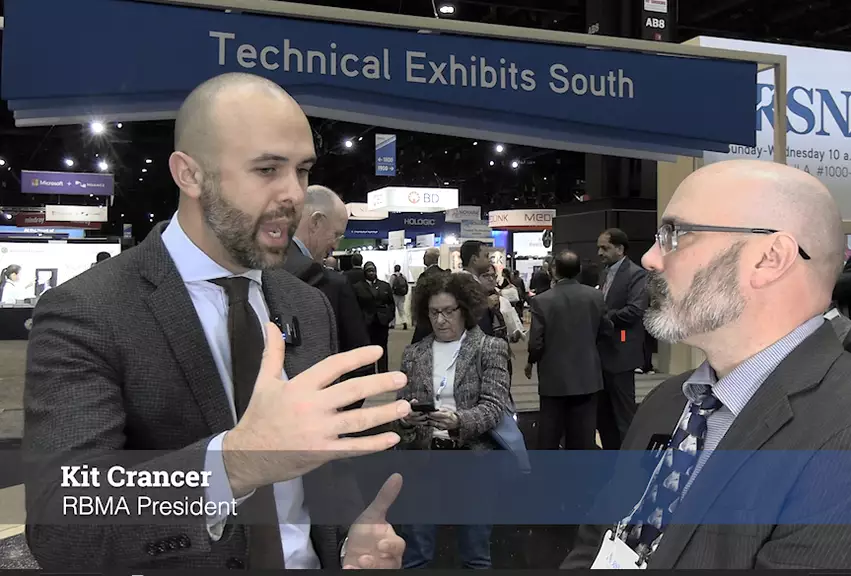4 key trends in radiology at RSNA 2023
The rapidly growing shortage of radiologists and technologists was by far the biggest point of discussion across sessions, discussions with vendors, industry analysts, physicians and professional societies at the Radiological Society of North America 2023 meeting.
Radiology Business found staffing issues were mentioned prominently in almost all discussions with vendors and in video interviews conducted this year at RSNA.
Here is an overview of four key trends we observed at RSNA 2023.
Radiologist shortage takes center stage
While the looming shortage has been discussed for several years at RSNA because medical schools in the United States are not graduating radiologists as fast as they have been retiring, the issue of staff shortages is now clearly pinching radiology. This issue was accelerated by the Great Resignation at the end of the COVID pandemic. Growing patient volumes, continued cuts in Medicare reimbursements and red tape issues with private payers have exacerbated both physician burnout and staffing challenges.
A walk down recruiters row on the RSNA show floor illustrated the crisis healthcare is now facing, where a record number of hospital systems showed up to try and fill vacant positions. Even on last day of the expo floor being open, when traffic typically drops, recruiters row was filled with attendees checking out their options in the current buyer's market. Out of the 27 hospital systems or recruitment services on the show floor, 15 were attending RSNA for the first time looking to fill empty positions.
"I speak with radiologists and practice administrators all over the country and one of the more frequent topics of conversation over the last year or so has been how difficult it has become to recruit physicians," explained Radiology Business Management Association President-elect Pete Moffatt, who also is SVP of business development at Advocate RCM. "The pressures of radiologist recruitment and trying to fill those jobs has taken up a lot of time on the administrative side. We keep hearing about burnout and that has a lot to do with fewer physicians having to carry the workload."
There are efforts by RBMA and other radiology societies to get younger students interested in radiology, advocating for policies to expand medical school and residency program slots for the specialty.
"We are seeing a large rise in demand for radiology services, but we have this capacity limitation. At the same time, we are seeing a downward pressure on reimbursement, and we are doing this in a period of inflation. So, it is like a perfect storm," said Richard Heller, MD, a member of the RSNA Board of Directors and associate chief medical officer for policy and communications at Radiology Partners.
Vendors across the expo floor also said they see staffing as one of the biggest challenges in radiology.
"Coming out of COVID, we have seen consistent staffing challenges across the board, from radiologists down to technologists, so there is a big push by hospitals to modernize infrastructure to improve efficiencies," said Isaac Zaworski, president of enterprise imaging vendor Sectra.
There were numerous sessions at RSNA on how to retain radiologists and to reduce burnout.
Watch a video interview with Michael Bruno, MD, on the mismatch between radiologist shortages and rising exam volumes.
Artificial intelligence can automatically contour the complex anatomical structures in the brain and quantify each of these and their 3D volume in seconds. This is an example of a study post-processed using the Vuno Med DeepBrain algorithm. It creates an automated report with more than 100 measurements. This can be used for tracking disease or therapy in patients over time with easily reproducible quantifications.
AI in radiology continues to expand in number and clinical use
RSNA by default is the largest conference for the clinical implementation of artificial intelligence in healthcare. AI made up by far the largest exhibitor product category at RSNA, with 242 vendors showcasing at least one such product. Medical imaging accounts for about 80% of the 692 clinical algorithms cleared so far by the U.S. Food and Drug Administration.
AI was discussed in the majority of booth tour conversations at RSNA in the context of how it is helping improve efficiencies and workflow for technologists and radiologists. Several vendors and radiologists Radiology Business spoke with said AI is being adopted, but it is often in one or two areas with one or two products. Radiologists are not currently ordering off of an extensive AI menu with dozens of AI applications, as many vendors originally envisioned.
Most of the clinical AI being implemented is currently concentrated in neuro/stroke and breast imaging. In stroke, AI is being used to do first-pass reviews of CT imaging right off the scanner, send immediate alerts to stroke care teams, or elevate suspected stroke cases to to top of reading lists. AI also can differentiate between ischemic and hemorrhagic strokes so care teams know how to treat the patient quickly.
In breast imaging, providers are using AI to help triage studies and identify which exams appear to be normal and which ones have cancer or suspicious lesions that require closer scrutiny. AI also can assign automated breast density scores and help radiologists process 3D mammo studies by telling them which slices have areas of interest to help reduce reading times.
"We used to be in an age where a standard mammogram only had four images, but now with tomosythesis that same study can now include over 200 images. Multiply that by 50, 75 or 100 cases a day and it is a massive volume of imaging to look at," said Samir Patel, MD, a diagnostic radiologist with Radiology Inc., who spoke during a session on advances in breast imaging. "There are AI algorithms out there that can reduce the number of tomosythesis images that need to be reviewed so it is easier to detect the cancers, some Ai reducing it by as much as two-thirds. These are becoming incorporated into clinical practice more and more today."
Continued reimbursement cuts require running lean radiology programs
Radiology has seen nearly consistent reductions in Medicare reimbursements for a decade. This is forcing some providers to consider no longer accepting Medicare patients because it costs more to provide services than what they are being paid by the Centers for Medicare & Medicaid Services.
"Looking at the Medicare physician fee schedule, there are significant cuts to diagnostic and interventional radiology," RBMA President Kit Crancer said during an interview with Radiology Business at RSNA. "We've had this chronic cycle that we've been in where we've looked at these reimbursement sets for the better part of the decade within our industry year. This year is no exception. So, we're looking at at least a 4% cut to the majority of providers, some more depending upon modality mix."
The CMS budget is limited by Congress, which created the policy of budget neutrality where the amount of money Medicare gets is fixed and the budget must remain balanced. As more patients demand certain services or some specialities receive incentive payments, it means cuts have to be made to other physicians' rates.
Medical societies believe access to healthcare is being put in jeopardy by the continuous cuts to provider pay.
"I think we're already there. A reimbursement cut to a radiologist, a reimbursement cut to a physician, is a cut to a Medicare beneficiary," Crancer said. "The fact is, so long as we have the budget neutrality structure in place, so long as CMS has their hands tied, it's really difficult to see a way out because we have an aging population that is now demanding more care than ever."
"It's almost like Groundhog Day the movie, where it is the same thing year after year and we wait to see how much they are going to cut radiology. Medicare said the system is set up where some years a speciality will be in the plus column and others they will be in the negative column. So, we went back and looked at how many years radiology was in the plus column, and it was not even once. What we see are constant reductions in reimbursement for radiology," added Rad Partners' Heller.
He noted that interventional radiology received the biggest overall under the 2023 physician fee schedule. This is ironic, Heller said, since Congress and CMS keep insisting they want value-based medicine, but paradoxically they are cutting one of the specialities that provides these types of cost-effective procedures.
"That seems to be the wrong way to be focusing on value," Heller said. "If you are disincentivizing investments in interventional radiology, then we are going to have issues with patients getting access to these services, and we are already seeing that."
Numerous sessions focused on how to be more efficient in radiology practice, including the use of new health IT technologies, and especially AI. Boosting workflow efficiency while reducing read or scan times was one of the primary mantras of all vendors across the expo floor, as well.
Elevation of cardiac CT
Larger imaging system vendors launched four new computed tomography systems on the expo floor at RSNA this year. Siemens, Canon and Fujifilm all said these new systems are aimed at the rapidly growing market for cardiovascular CT. Coronary CT angiography (CCTA) was granted a Class 1A recommendation for front-line imaging of chest pain patients in the 2021 American Heart Association and American College of Cardiology Chest Pain Guidelines.
Some health systems like Northwell have seen a more than 200% increase in CCTA exams over the past two years. While many medical conferences are still impacted by the pandemic, the Society of Cardiovascular Computed Tomography 2023 meeting recorded record breaking attendance, and hands-on training sessions were sold out amid rising interest in how to perform these exams. Outpatient CCTA evaluations also are seeing expansion.
"There is definitely a shift in the needle with the types of procedures that are being performed on CT systems," Bhvita Jani, medical imaging principal market analyst for Signify Research, said in an interview with Radiology Business. "Changes in the guidelines recommending CT for coronary artery screenings led to multiple vendors launching new CT systems and other technologies, which enable better coronary artery disease screening. This helps patients by avoiding admissions to hospitals for invasive procedures in the cath lab."
The U.S. is actually lagging behind other countries in Europe, which embraced CCTA several years ago as a front-line cardiac imaging test, she said.
It is unusual for vendors to release four new CT systems at the same RSNA, and the fact that all of these systems have marketing aimed at CCTA is an indication of how big of a trend this is, experts told Radiology Business.
Attendance numbers at RSNA 2023
RSNA reported total registration for its 2023 meeting at 40,661. Of these attendees, professionals made up 21,056 and the rest were vendors.
This is higher than registration for RSNA 2022, which had nearly 38,000 attendees, and has started to reach the pre-pandemic numbers, which ranged between 40,000 to 50,000.
There were 691 exhibitors at RSNA 2023, including 133 first-time RSNA exhibitor.
The conference and expo floor appeared very busy with large crowds. Even on the fourth and final day of exhibit hall hours, the floor was still filled with attendees and some vendors did not have open work stations for demos.





